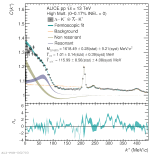Figures from paper submitted to Physics Letters B
Abstract:
The interaction between $\Lambda$ baryons and kaons/antikaons is a crucial ingredient for the strangeness $S=0$ and $S=-2$ sector of the meson$-$baryon interaction at low energies. In particular, the $\Lambda{\mathrm{\overline{K}}}$ might help in understanding the origin of states such as the $\Xi\mathrm{(1620)}$, whose nature and properties are still under debate. Experimental data on $\Lambda$$-$${\mathrm{K}}$ and $\Lambda$$-$${\mathrm{\overline{K}}}$ systems are scarce, leading to large uncertainties and tension between the available theoretical predictions constrained by such data. In this Letter we present the measurements of $\Lambda$$-$K$^+\oplus \overline{\Lambda}$$-$K$^-$ and $\Lambda$$-$K$^-\oplus \overline{\Lambda}$$-$K$^+$ correlations obtained in the high-multiplicity triggered data sample in pp collisions at $\sqrt{s}=13$ TeV recorded by ALICE at the LHC. The correlation function for both pairs is modeled using the Lednicky$-$Lyuboshits analytical formula and the corresponding scattering parameters are extracted. The $\Lambda$$-$K$^-\oplus \overline{\Lambda}$$-$K$^+$ correlations show the presence of several structures at relative momenta $k^*$ above 200 MeV/$c$, compatible with the $\Omega$ baryon, the $\Xi\mathrm{(1690)}$, and $\Xi\mathrm{(1820)}$ resonances decaying into $\Lambda$$-$K$^-$ pairs. The low $k^*$ region in the $\Lambda$$-$K$^-\oplus \overline{\Lambda}$$-$K$^+$ also exhibits the presence of the $\Xi\mathrm{(1620)}$ state, expected to strongly couple to the measured pair. The presented data allow to access the $\Lambda$K$^+$ and $\Lambda$K$^-$ strong interaction with an unprecedented precision and deliver the first experimental observation of the $\Xi\mathrm{(1620)}$ decaying into $\Lambda$K$^-$.
Phys. Lett. B 845 (2023) 138145
e-Print: arXiv:2305.19093 | PDF | inSPIRE





